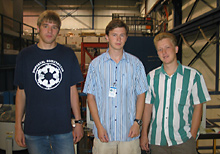 | Thursday, August 4, 2005 |
|
Thursday, August 4 2:30 p.m. Theoretical Physics Seminar - Curia II Speaker: H. Nunokawa, Pontifícia Univ. Católica do Rio de Janeiro Title: Establishing Neutrino Mass Hierarchy and CP Violation by Superbeam with Twin Megaton Detectors 3:30 p.m. Director's Coffee Break - 2nd Flr X-Over Note: There will be no accelerator physics and technology seminar today
Friday, August 5 |
|
Extended Forecast |
Secon Level 3 |
|
Thursday, August 4 Tomato Florentine Soup Grilled Chicken Cordon Bleu Sandwich $4.85 Chimichangas $3.75 Chicken Marsala $3.75 Smoked Turkey Melt $4.75 Italian Sausage Calzones $3.50 SW Chicken Salad with Roasted Corn Salsa $4.85 The Wilson Hall Cafe now accepts Visa, Master Card, Discover and American Express at Cash Register #1. |
|
Thursday, August 4 Dinner Smoked Salmon Plate Veal Picatta Spinach Fetuccini w/Tomatoes & Cream Chocolate Fondue w/Fruit
Wednesday, August 10
Chez Leon Menu |
| Fermilab Today is online at: http://www.fnal.gov/today/ Send comments and suggestions to today@fnal.gov Fermilab Today archive Fermilab Today PDF Version Fermilab Result of the Week archive Fermilab Safety Tip of the Week archive Linear Collider News archive Fermilab Today classifieds Subscribe/Unsubscribe to |
|
DISUN Connects Universities to the LHC Through Grid Computing Scientific research and grid computing at universities across the country took a big step forward recently with an award of $10 million from the National Science Foundation to the Data Intensive Science University Network. DISUN will allow over 200 physicists at U.S. universities to study the fundamental properties of particles and forces by providing access to data from the Compact Muon Solenoid experiment at the Large Hadron Collider at CERN in Geneva, Switzerland. |
|
August 1 - August 3 - During this 48 hour period Operations established two stores that combined with an existing store provided the experiments with approximately 41 hours and 26 minutes of luminosity - Pelletron network problems
Read the Current Accelerator Update |
|
From The New York Times, August 2, 2005 Lacking Hard Data, Theorists Try Democracy By Dennis Overbye TORONTO — Science is not done by popular vote. But nothing can be taken for granted when string theory is the subject. So when Stephen Shenker, a Stanford University theorist who was moderating a panel discussion here on the future of the putative theory of everything, asked for a show of hands on the fate of a strange number known as the cosmological constant, some 400 physicists and mathematicians were happy to swallow their doubts and vote. The panel discussion, titled "The Next Superstring Revolution," took place at Strings05, the latest yearly congress of string theorists, held in mid-July at the University of Toronto. That it was a somewhat unusual occasion was not lost on anyone. No other field of science, said Jacques Distler, from the University of Texas, would be presumptuous enough to have a meeting about its next revolution. But then no other field of science is like string theory, which says that nature with all its forces and particles is composed of tiny strings wriggling in 10 dimensions. In the last two decades it has taken academia by storm, and it has been rocked by periodic reinventions. |
|
Looking for sTop Signs | ||
| ||
|
One of the great challenges facing science today is the unification of the forces of nature. One theoretical way to unify the interactions of the elementary particles is to introduce an extension to the Standard Model of particle physics called supersymmetry (SUSY). In this extended theory, new particles are introduced that are partners of the known particles. For example, the Top quark, which was discovered at Fermilab by the DZero and CDF experiments, would have a SUSY partner referred to as a sTop. SUSY particles could also be the mysterious dark matter that pervades the universe and our galaxy, so it is of great importance to find these particles if they exist.
Interestingly enough, the sTop--the superpartner of the heaviest quark of the Standard Model--might be the lightest SUSY quark. At DZero, a sTop pair created in a proton-antiproton interaction could decay into a pair of bottom quarks, leptons and sneutrinos, the latter decaying into neutrino and another SUSY particle. A first search for the sTop has focused on final states with two muons. These final states are overwhelmingly dominated by the decays of the Standard Model Z boson into muons as well as multijet events involving muons. Making maximum use of the topological difference between Z and sTop events, only one b-tagged jet is required, leading to a diminished contamination after the final selection, while preserving the sTop signal. No sign of SUSY has yet been observed at low sTop masses. With 0.5 fb-1 data in both dimuon and emu final states, a higher range of sTop masses will soon be explored. | ||
| ||
| ||
|
Result of the Week Archive
|
|
Fermilab Film Series The Fermilab Film Series will present "The Great Escape" on Friday, August 5 at 8:00 p.m. in Ramsey Auditorium. Tickets are $5. More Information
Fermilab Arts Series
Tour of Victorian Mansion
Batavia Fine Arts Festival
SciTech Exhibit |



